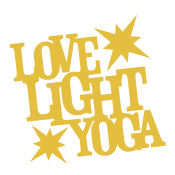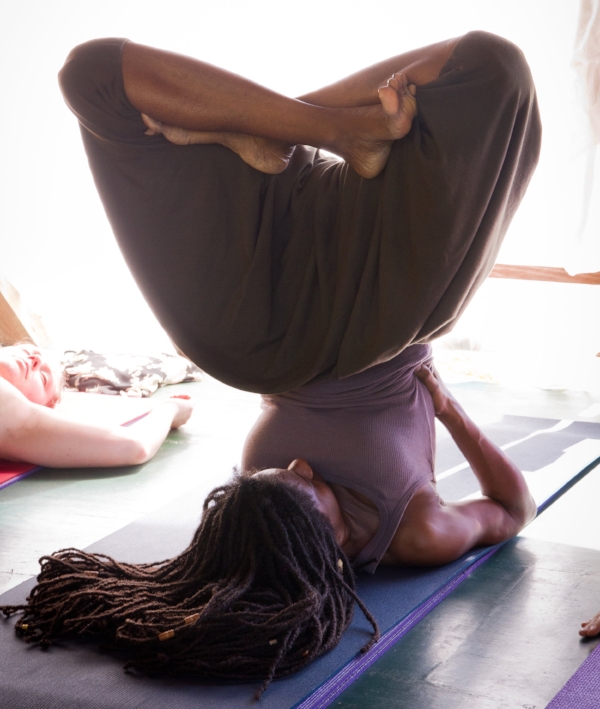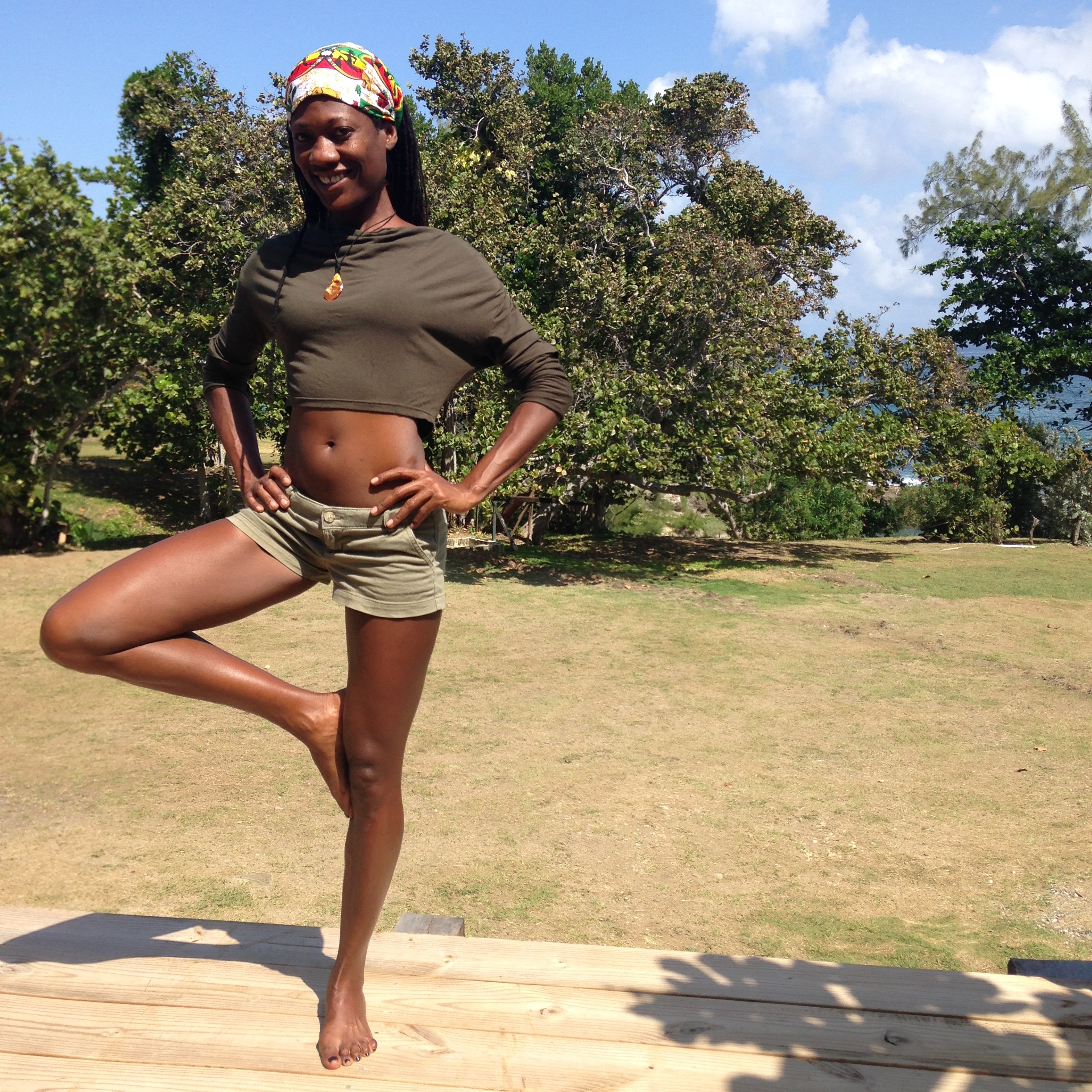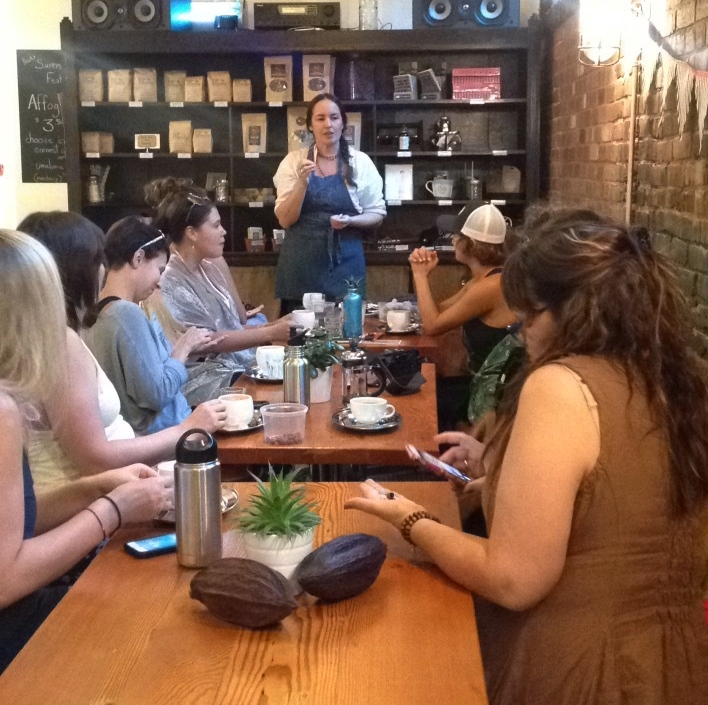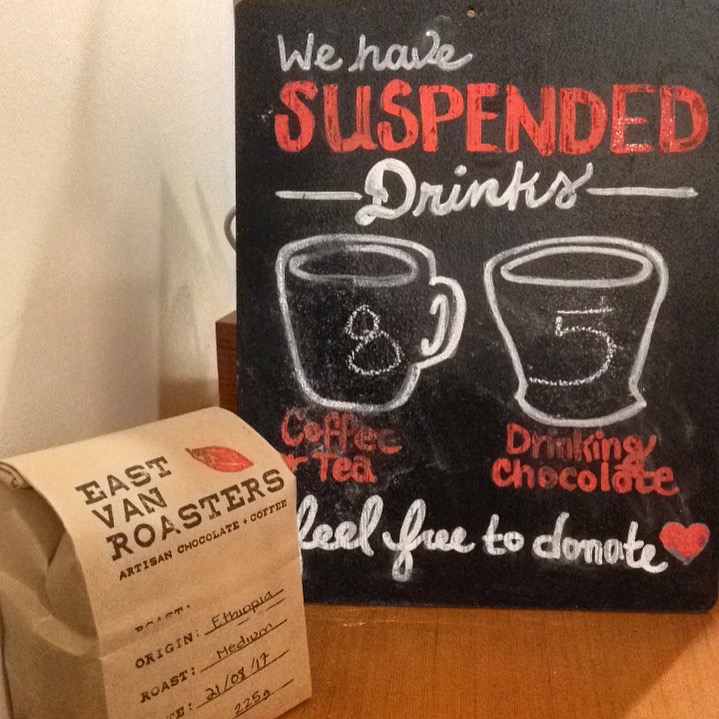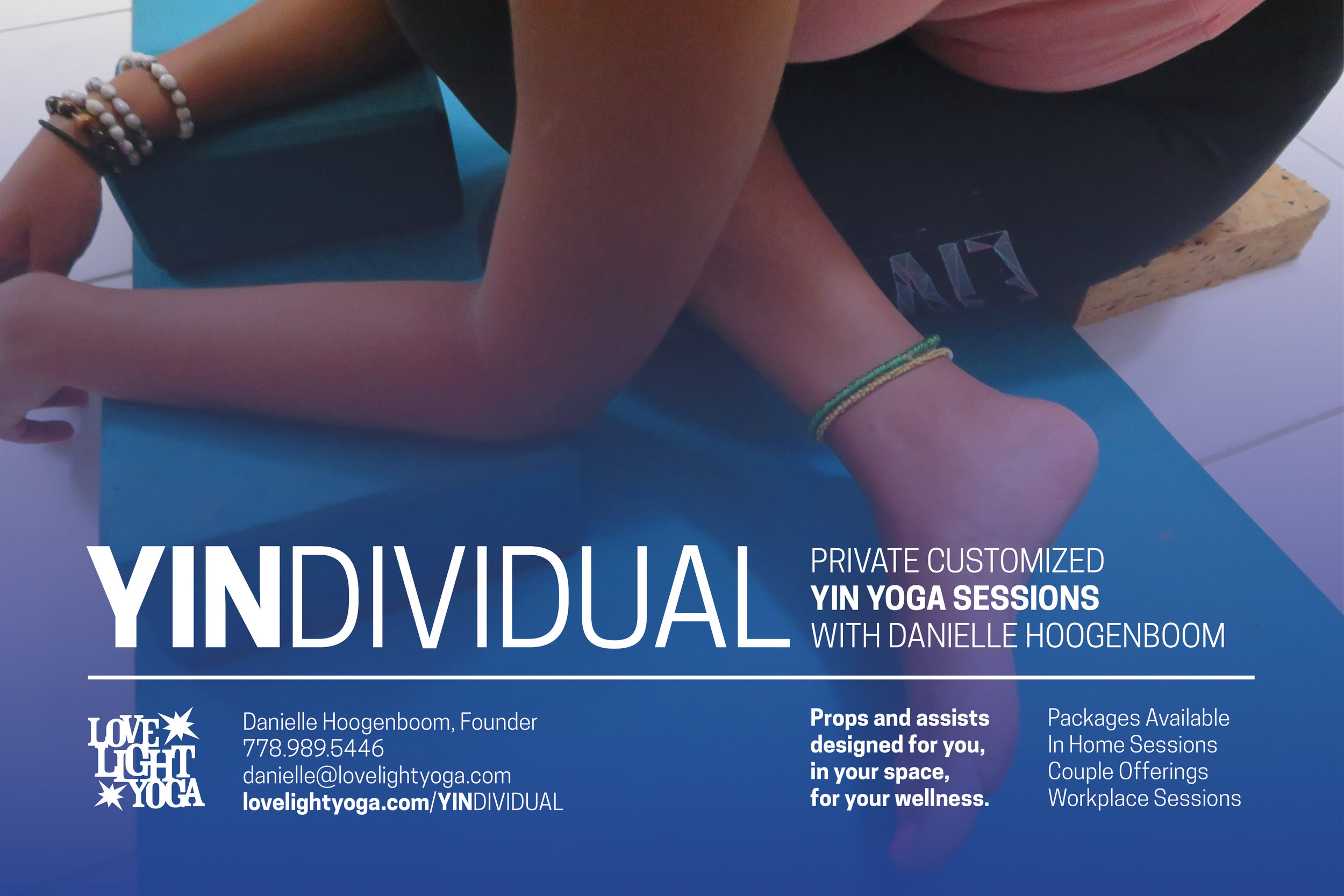The first time I went to a Yin class was in 2011. It was candlelight yin and even though the poses were held for so long I felt so relaxed that parts of my body shifted. I do not consider myself a yogi even though I do own a yoga mat, a bolster, straps and blocks. I have been practicing yoga on and off for over 15 years. I first was exposed to it at age 10 from a family friend who definitely would be a self-identifying yogi. I liked feeling strong when I did it so it makes sense that when I was reintroduced to it as a young adult, it felt like “home” in my body.
When I signed up for the Yin and Justice course, I was drawn to it because I love yin yoga so much. The justice aspect was something I was curious about and since my friend Chastity was going to be involved I wanted to participate. We were required to submit our thoughts before the course started. We had to say what we wanted to leave behind and what we wanted to keep with us that was working for us in regards to oppression. I had to look up the definition to fully absorb the idea of this word.
op·pres·sion
noun
prolonged cruel or unjust treatment or control.
"a region shattered by oppression and killing"
synonyms:
persecution, abuse, maltreatment, ill-treatment, tyranny, despotism, repression, suppression, subjection, subjugation;More
synonyms:
persecution, abuse, maltreatment, ill-treatment, tyranny, despotism, repression, suppression, subjection, subjugation;More
"her mood had initially been alarm and a sense of oppression"
It is such a strong word. The definition makes it sound like the worst thing imaginable. And that is exactly what it is. It is this horrible feeling that makes me feel shame, insecure, scared, alone. So much emotion by one word. I feel all those feelings and it makes me want to cry. But then I tell myself I am ok, I am here today because I have overcome oppression time and time again.
I have heard the word lots before but never used it myself. I said in my response that I wanted to leave behind my anger and I wanted to keep up my ability to speak up for those that cannot.
Danielle called me back to say I was welcome to join in the course. She said she was drawn to my statement about being so angry. It is nice to get a positive response to anger. Most people coil away from that emotion.
I am angry. And hurt. My body knows these feelings too well. The anger sits in my hips and my neck. My hurt is heavy in my chest and sometimes I catch myself holding my breath. Yin yoga holds poses for long periods of time so that you learn to “sit” through the pain until it releases, which gives new blood flow to areas that were locked up before. My anger has me locked up and I need to stretch it out of me!
I learned a lot in the 4 day course. It was difficult to stay present sometimes. The conversations got heavy. I cried too often when I spoke. We were a group of women sitting and stretching together while talking about how to be more aware of how we engage; within ourselves and in the world. All around the idea of oppression and white privilege. I am certain it was just by chance that we were all women, but it would have been nice to have a couple guys there as well.
The yin aspect was great for me because I am a physical person who absorbs things better if I get to be moving. We learned about the 5 elements and how there are yin organs that correlate with each element.
Quoting Danielle, “Anger lets you feel the love. Anger is the wood element. Love is the fire element. You need wood to make fire.” It’s so beautifully simple. I am grateful for my anger, because it has been feeding my fire my whole life. I didn’t let go of my anger after the course, but I am learning to be kind to myself for being angry. I need to stay in love with who I am while being angry.
A lot of women in the course work in social services and literally live in the “justice” world. I do not. I work as an electrician. In a man’s world where I am congratulated all the time for being there. Women always say, “Oh, that is so great you are an electrician. I wish I was brave enough to do that.” Or “tough enough.” Something along those lines is the standard statement. Men also congratulate me, saying “good for you!” I guess that is them acknowledging that it must be hard. But for some reason, I always dismiss their congratulations. I think it is because I wish I could just be an electrician without being congratulated. It is our internal systems that have been set since birth – gender specification. Boys are meant to play with cars and wear blue. Girls are meant to like dolls and the colour pink. Those ideas are what start a life long internal dialogue of how we are supposed to be in this world. I heard my nephew tell me that I couldn’t do something because it was for boys. I was saddened that he had this idea already, but I accept the challenge to change his idea. I have to change my own ideas of the way to be every single day.
We had this one exercise where we had to stand in the room based on a scale of 0 to 10. 0 being one wall and the otherside being 10. When a question was asked, we had to stand where we thought we were on the scale. Then Dia asked 2 different people on opposite ends of the scale to say why they stood there. One question was “individual” and “community.” Everyone but me stood closer to the “community” wall. I was on the other side of the room, identifying myself as an 8 on the scale, closer to “individual.” When asked why I was there, I got emotional and did my best to summarize my reasoning. I said that I wished I had a sense of community and would love to be standing over there with everyone but the only reason I am where I am today is because of me. I had to figure it all out and I did it without a supportive family. My parents are both gone and even when they were alive, it was me working to keep them functional. My “individual” state is something I have had to be in order to thrive at life. One of the girls moved closer to my side when I started to say all this and she later confided she felt the same way. We also had another question on “feminine” and “masculine.” I was alone on that one too. When the “feminine” was asked what that meant, the answer was surprising to me. It was about being soft and comforting. The words chosen were all the positive aspects of “feminine.” But those were not the thoughts I had when I heard the question. I thought about my mother and my step-mother. Two women with amazing artistic, feminine qualities who were dependent on my father because they were not educated and couldn’t make their own money. I stood closer to “masculine” because I figured the only way to survive is to be like one of the boys. Don’t get married, because then I will have to have kids and if I have kids then I have to stay at home and if I stay at home I am dependent on the husband. Then I become lost. Being a mother and a wife. Not myself. That was my internal dialogue in less than a second. It is interesting to hear other people’s reasons for choosing things. It opens up something inside me, or maybe it actually takes down some walls I have been keeping up for a long time. It was a good exercise and sticks out in my mind strongly.
Dia said that “white privilege experiences loss to create equity.” I understand that to mean, in order for it to be an equal playing field, the white privilege needs to end. The idea of oppression is absent in a white persons head because they do not have to consider it an issue. When they fill out an application form for a job, they do not have to check off any box that asks if they identify as a visible minority, a status Indian, a non-status Indian, a metis. I look white but I still have to check off one of those boxes. Next to that I also have to check off the female box. Boom….in 2 check marks I have triggered any employers idea of what to expect from me. White privilege comes along and says “Oh man, you are native AND a girl! You must have it so easy!” Then I have to remember to breathe and explain that I am actually having a harder time as a female, native woman in BC trying to find a job as an electrician. That statistically, since I started in the trade in 2011 there were only 3% of women in the electrical trade. A statistic that has not changed 6 years later. So when I get congratulated on being an electrician, I dismiss it. Because I should not be congratulated. I just want to be treated the same as everyone else… an equal.
I was born to a Dene mother and white father. I was always told by my mother that I was a half breed. A term I still use today which probably some people are not comfortable with. My mom also told me I am half Chip (short for Chipewyan), which 7 years ago my cousin said that I cannot say that anymore. I had to look up the origins of this word to understand why. Being told “you can’t say that anymore, it’s not politically correct” is not enough of a reason to me. Turns out it was the Cree who called us Chipewyan because of the way our leather clothes were designed, with points at the end. It was not something we called ourselves, therefore we were no longer going to use that name. I accept that reason because it makes sense to me. I am sure a lot of people would think twice about using certain words or terms if they knew how they originated.
My father grew up with a deep rich heritage filled with prairie French and privilege consisting of a successful family owned business and an excellent education. My white grandmother Solange experienced lots of difficulties. She lost her husband while she had a 2 year old daughter, a 12 year old son (my father), 14 year old and 16 year old daughters. She herself was triggered by his sudden death and succumbed to a lifelong battle, which is now known as bipolar disorder. Somehow she managed to keep the family business afloat despite being a woman in the 1950’s running a gas station in western Saskatchewan. Men made it very clear to her that she had no place running that business and was eventually bought out by one of the men who told her so. She may have had white privilege, but she definitely was a woman working in a man’s world. My father always spoke so proudly of his mother, my grandmother Solange (Sally to the English speakers). I am certain it is why my father wanted to empower the First Nations in Canada. He witnessed oppression his mother experienced as a widow with a family to support, running a gas station post-war. I never knew that was the word I was looking for…. Oppression.
Reading the other guest blogs from the course, I feel like mine isn’t ready or good enough to be posted. But I have put this on the back burner for a month, stewing in my mind. I slept a lot after the yin and justice course, recovering from the mind opening experience. I read Dia’s blog, about the 5 stages of grief in accepting white privilege and recognizing the impacts of being colonized. Chastity had said that we are all products of colonization, either as the “colonized” or “colonizer.” My internal struggle is real and I am a product of both sides. My mother’s family all suffer from being colonized. My reserve is Clearwater River Dene Nation, which is just next to the village of LaLoche, SK.
Last year there was a mass school shooting and it shook me to the core. My father was a teacher in LaLoche 40 years ago. He could have been the white male teacher that was killed. My 2nd cousin was wounded in the shooting and we only met after it all happened because I never go back to the reserve. I met Chastity through our mutual friend Duane Howard, who is an actor and Drug & Alcohol counsellor. They felt called to go to LaLoche and perform a Letting Go ceremony. I brought them to my community, but like I said earlier, there is no sense of community for me even there. I have family there and they are always so gracious and welcoming. But the average person who doesn’t know me sees my white skin and thinks I am a new school teacher in town. The stand-in Mayor told me to my face that I am not from there. It all hurt, just like the whole community is hurting. In a state of shock, they all walk around doing the best they can to get through every day. And that is what I do here, thousands of miles away.
I struggle with acceptance and a sense of security. Apparently, this is a result of being colonized. The “Indian” in me was to be killed out by the government when they came to Canada. Land was taken from us and so were our homes. My mother and her siblings all went to Residential Schools (my mom only went to grade 3). My grandmother was not even registered at birth, because back then a lot of families would not report their new births. The crimes and abuse they experienced are in my blood. We were made to not feel secure, to have self-doubt. I read so many books about the horrible history of Canada and it makes me angry. I want to be the white privileged kid, who is ignorant to the crimes against my native side. But I do not let myself be the white privileged kid. Instead I silently lick my wounds and hope that my pain isn’t so obvious. I want to be a softer person who can remember empathy and compassion when people are so ignorant. So, I will just remember to breathe, stretch out my muscles and remember that I am trying to be better a person, and that makes it worth it.
